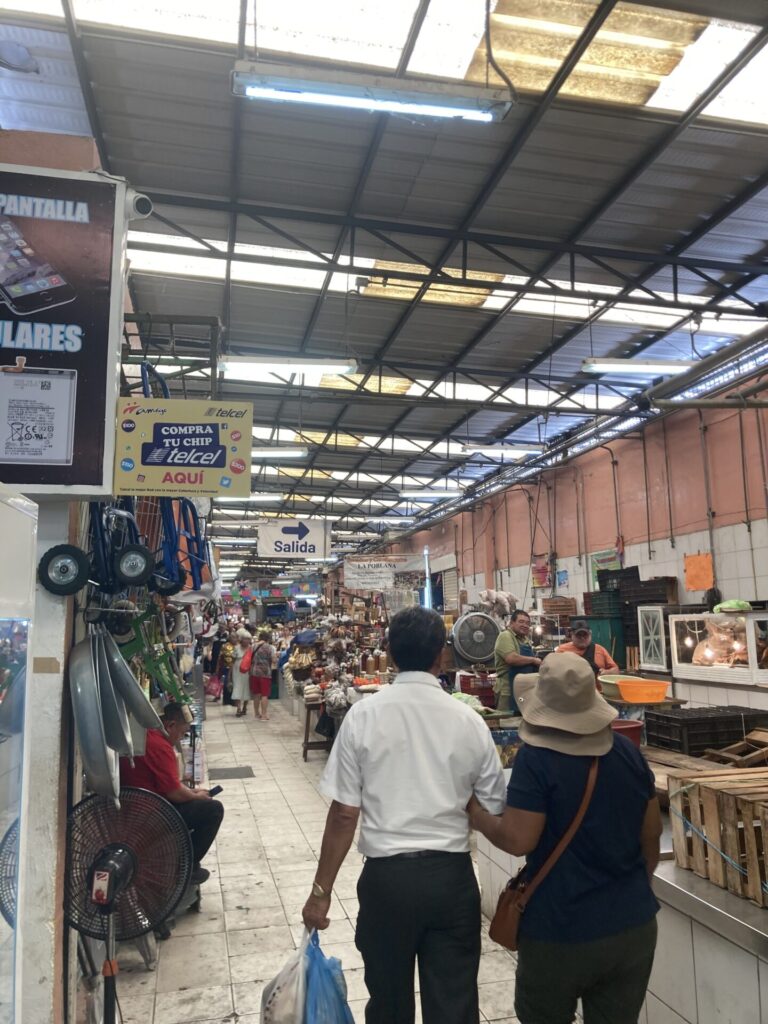
Last Wednesday we watched the documentary Cannibal Tours (O’Rourke, 1988). This film presented a complicated narrative following a group of European tourists through several native villages in Papua New Guinea. They toted comically large and loud cameras whose shutters intruded on everything including interviews and mangroves. Every click of the camera was intentional as they had limited film. The power was in their hands. They chose what to document about these people’s lives, their stories, their history. The tourists’ ancestors had already destroyed and rebuilt Papua New Guinea’s history, and in a way the tourists continued this “tradition”.
I have found myself thinking guiltily about my excessive usage of cameras since arriving here in Mérida. I rented a camera from the Honors Equipment Office with the intention of filming this trip by creating a video diary. I brought two other, smaller digital cameras. I most frequently use the camera I carry in my pocket on my phone.

Early last week I made my way to Mercado Lucas de Galvez. I was excited: the market seemed to stretch on forever, and when my mother visited Mérida she went to the same place. It was bustling and huge, with phone repair shops right next to barber shops and meat hanging next to produce. It had everything you could think of. From my observation, I was one of few Americans there, though that wasn’t necessarily my focus. And the entire time, I had my obtrusive camera around my neck. I can imagine how I looked to people just trying to buy groceries, to get some new shoes. I probably looked like an idiot. I found this place to be special and beautiful but it is also many people’s every day life. Is there something wrong with romanticizing it?
I think I struggle with this question. I don’t know if there is anything inherently wrong with taking pictures and videos. I think that what can be wrong about it is the intention. Why are we taking photos? What do we intend to do with them? Building off of that, why are we here? Why do we want to be in Mérida, to study abroad here? How are we spending our time? Are we existing in this space or taking advantage of it?
I think I take pictures and videos to remember. I want to remember the places I am visiting and what I experienced there. I find beauty in so many places here in Mérida and Mexico. I enjoy documenting my experiences through photography at home as well, but the act of photography is inherently different here because I am a tourist. I think on some level taking videos and photos is about ownership. Ownership of memories, of experiences, of places. These tourists in Papua New Guinea, they had no Instagram to post on. Still, they wanted to exhibit that they were there. They wanted to be able to show someone. And they wanted to form a specific narrative about that place. I can’t say that I am all that different, because in choosing what to take pictures of I am choosing what to share with family, and friends. I am choosing what to show, if in a different way.

I visited Graciela Iturbide’s photography exhibit in the Casa Montejo with some friends last week. She documented many places and people, mostly in Mexico. In her work we found portraits and captured moments, some candid and some staged, all in black and white. I found myself wanting to recreate her works, to emulate this beauty that she has captured. But Graciela Iturbide is a Mexican woman who documents people throughout Mexico, showing their emotion and their experiences through her own. If I were to document the people of Mexico from my identity as a white American woman, would it not be voyeuristic and exploitative? I think there is a fine line between appreciation, documentation, and exploitation, and I do not have an easy answer as to which is which.
This reminds me again of the documentary, created by a white Australian man. He writes of Cannibal Tours that “it is certainly a documentary film, but it is also a fiction because it is an artefact, that is: someone made it” (O’Rourke, p. 3, 1999). He even comments in “On the Making of Cannibal Tours” that his act of photography is voyeuristic in itself. This film is not purely observational: someone had to press record and stop, point the camera, edit the footage, record and add sound. These choices all form a narrative, a story. O’Rourke is clearly critical of these tourists and their place in Papua New Guinea, but he does sympathize with them, and his documentation is no doubt influenced by his position staying on the same ship as them and coming from Australia as a white man. He also speaks the same language that the people in Papua New Guinea do, and this is important to note too. It’s not that he’s unaware of this complexity, but he chooses to approach the filmmaking in a self reflexive way.
I struggle with the line between self awareness and hypocrisy. I don’t know what is “okay” to take a picture or video of, necessarily. We are in a completely different environment than Papua New Guinea, but the aspects of tourism criticized and discussed in Cannibal Tours are still important to think about. Choosing what to document is inevitably choosing a story to tell, and choosing how to document it is the same. We can easily be exploitative as tourists, taking advantage of a place instead of coexisting within it, and I think it’s important to think about how we are approaching the spaces we are in, and why are are approaching them that way.